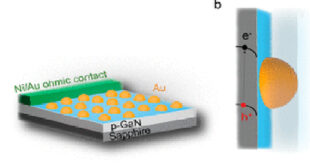Significance Statement
Rhenium disulfide (ReS2) is a new type of 2D semiconductors with intriguing properties. In contrast to the widely studied group-VI transition metal dichalcogenides (TMDs), such as MoS2 and WSe2, that possess 1H or 1T structure, ReS2 monolayers exhibit unique distorted 1T structure as the stable phase. As a consequence, the ReS2 crystal exhibits strong in-plane anisotropy in the electronic, vibrational, and mechanical properties. Such in-plane lattice distortion is expected to profoundly affect the interlayer coupling in few-layer ReS2 crystals.
Here we use ultralow-frequency Raman spectroscopy to explore the interlayer coupling and stacking order of ReS2 atomic layers. Our experiment reveals a panoply of Raman modes in the frequency range of 5 − 50 cm−1. These Raman features arise from the interlayer shear (S) and breathing (B) phonon modes with lateral and vertical rigid layer displacement, respectively. As the interlayer modes are generated directly from the coupling between individual layers, their emergence indicates non-negligible interlayer coupling and well-defined stacking order in the ReS2 crystals. In addition, ReS2 exhibits rich low-frequency Raman spectra with a plethora of shear modes, which are activated by the low crystal symmetry of ReS2. In particular, the in-plane anisotropy lifts the degeneracy between shear modes with layer displacement parallel (S∥) and perpendicular (S⊥) to the rhenium chains. The two types of shear modes are thus clearly resolved in the Raman spectra. These features contrast sharply with the two-fold degenerate shear modes observed in other 2D materials. By carrying out comprehensive first-principles calculations, we can account excellently for the frequency and Raman intensity of the interlayer modes and determine the stacking order in bilayer (2L) ReS2. Our findings of the layer coupling and structure of ReS2 are critical to understand the optical and electronic properties of this material, and more generally, of all anisotropic 2D materials, such as ReSe2 and black phosphorus.
Figure Legend: (Top row) The side-view schematics of the interlayer shear modes with layer displacement parallel (S∥) and perpendicular (S⊥) to the rhenium chain and the interlayer breathing mode (B) in bilayer ReS2. (Bottom row) The Raman spectrum for the interlayer modes, and the top view of the associated interlayer stacking order. For clarity, only the rhenium chains are shown in the top view, and the rhenium atoms in the bottom layer are displayed with lighter color. The blue and green arrows in both the side view and top view denote the layer displacement of the S∥ and S⊥ modes, respectively.

Journal Reference
Nano Lett., 2016, 16 (2), pp 1404–1409.
Rui He1, Jia-An Yan2, Zongyou Yin3, Zhipeng Ye1, Gaihua Ye1, Jason Cheng1, Ju Li3, C. H. Lui*4
[expand title=”Show Affiliations”]- Department of Physics, University of Northern Iowa, Cedar Falls, Iowa 50614, United States
- Department of Physics, Astronomy, and Geosciences, Towson University, Towson, Maryland 21252, United States
- Department of Nuclear Science and Engineering and Department of Materials Science and Engineering, Massachusetts Institute of Technology, Cambridge, Massachusetts 02139, United States
- Department of Physics and Astronomy, University of California, Riverside, California 92521, United States
Abstract
We investigate the ultralow-frequency Raman response of atomically thin ReS2, a special type of two-dimensional (2D) semiconductors with unique distorted 1T structure. Bilayer and few-layer ReS2 exhibit rich Raman spectra at frequencies below 50 cm–1, where a panoply of interlayer shear and breathing modes are observed. The emergence of these interlayer phonon modes indicate that the ReS2 layers are coupled and orderly stacked. Whereas the interlayer breathing modes behave similarly to those in other 2D layered crystals, the shear modes exhibit distinctive behavior due to the in-plane lattice distortion. In particular, the two shear modes in bilayer ReS2are nondegenerate and clearly resolved in the Raman spectrum, in contrast to the doubly degenerate shear modes in other 2D materials. By carrying out comprehensive first-principles calculations, we can account for the frequency and Raman intensity of the interlayer modes and determine the stacking order in bilayer ReS2.
Copyright © 2016 American Chemical Society
Go To Nano Lett
 Advances in Engineering Advances in Engineering features breaking research judged by Advances in Engineering advisory team to be of key importance in the Engineering field. Papers are selected from over 10,000 published each week from most peer reviewed journals.
Advances in Engineering Advances in Engineering features breaking research judged by Advances in Engineering advisory team to be of key importance in the Engineering field. Papers are selected from over 10,000 published each week from most peer reviewed journals.



